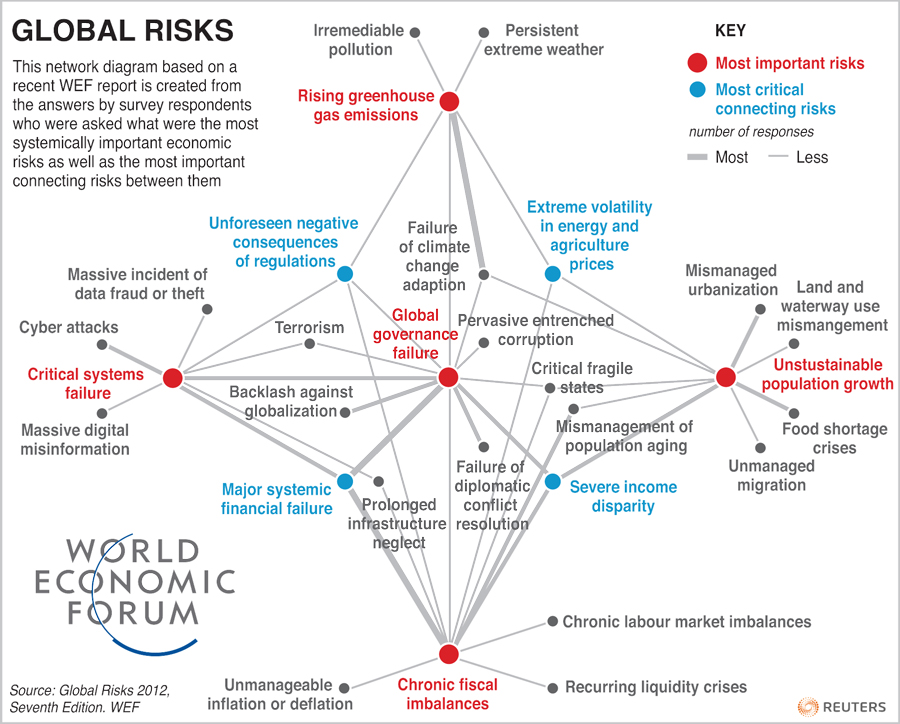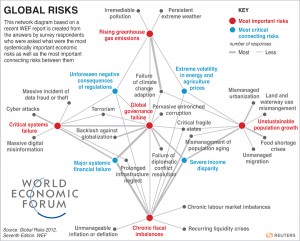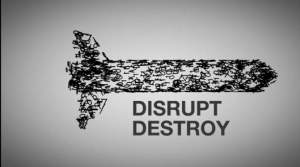
24 Jan World Economic Forum and Risks
Thanks to Stuart Elden for the lead.
First, it’s important to note that this diagram is based from responses of WEF survey respondents. These are “469 experts and industry leaders who worry that the world’s institutions are ill-equipped to cope with today’s interconnected, rapidly evolving risks. The findings of the survey fed into an analysis of three major risk cases: Seeds of Dystopia; Unsafe Safeguards and the Dark Side of Connectivity. Report also analyses the top 10 risks in five categories – economic, environmental, geopolitical, societal and technological.”
Even more exciting (besides the vagueness of the descriptions) is the interactive data explorer available on the WEF website. Among the data points that you can fiddle by are the respondents – including academics. It is too much fun to click around and see what is most important to particular stake holders in each category. 
But i can’t stop fiddling with the terminology of this chart (click for larger image). There is something delicious about toying with the linguistic turns. “Unforeseen negative consequences of regulations” – i wonder where “Unforeseen negative consequences of lack of regulation” would fit? Particularly in light of it being a “critical connecting risk” to “rising greenhouse gas emissions” and “critical systems failure.” How are “rising greenhouse gases” and “persistent extreme weather” not issues of non-regulation?
I wonder if “data fraud and theft” and “”cyber attacks” aren’t actually a shout-out to the DNS attacks and Wikileaks? We see you, but we don’t recognize you. The video on the front page draws a rather bleak image of the connectivity of the “seeds of dystopia” to the insecurity of the internet. “It’s the great irony of our information age,” Obama interjects, “the very technologies that empower us to create and to build also empower those who would disrupt and destroy” [insert picture of nuclear missile]. Oh wait, i screen captured it:
The message couldn’t be clearer: instability in North Africa and the Middle East is being driven through cyberspace. Wait, no, i mean those spray paint cans are the culprits for “unsustainable population growth” – again, obviously a problem of Over There. Because, as we can see, the income inequality and poverty of the world is more an issue of “chronic fiscal imbalances”, “unmanageable inflation or deflation” – not the “negative consequences of regulation” – nope – that’s just a greenhouse and cyberspace problem… the rest is a problem of too many brown people needing too much food to eat. Good thing they don’t have computers – or they, too, could be inundated with “massive digital misinformation”, which as we know, is a major issue in global governance failure” which is really just part and parcel of the “backlash against globalization” (which has a hefty response ratio, actually).
Wow. Thank goodness they figured it all out for us!
In all seriousness, though, it is curious the way that the respondents are mapped. I’m not a quant person, but i can’t help but wonder what Edward Tufte would have to say about it all?



Pingback:Global risks (apparently) | Progressive Geographies
Posted at 00:56h, 25 January[…] via Nick Srnicek – click on it to expand. I know this is ‘economic risks’ but interesting to see how minor a position ‘terrorism’ has. How would it have been seen ten years ago? [Update: some analysis here] […]